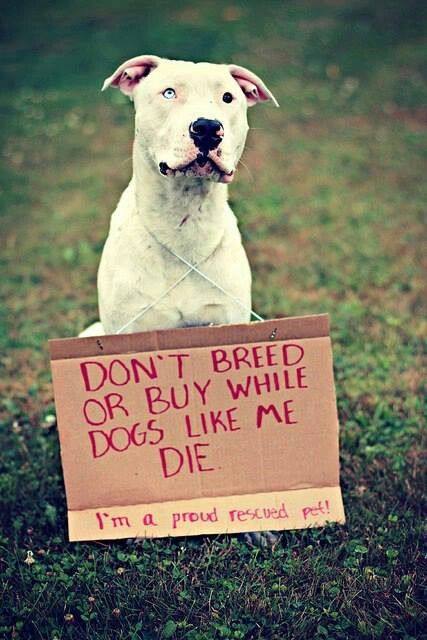Don’t Shop for Love—It’s Waiting Behind Shelter Bars

Don’t Shop for Love—It’s Waiting Behind Shelter Bars
In the quiet corners of animal shelters across the world, a silent plea echoes from behind cold, metal bars. A dog sits there, his eyes following the parade of families that pass by, their gazes often lingering on the “prettier” dogs with glossy coats or pedigreed lineage. He didn’t choose to be abandoned. He didn’t understand why no one came for him. Day after day, he watches, hope flickering like a candle in the wind, waiting for someone to see past his scars, his matted fur, or the uncertainty in his posture. But today, he has a voice: “Don’t breed or buy… while dogs like me die.” Behind every shelter gate lies a heart that still believes in humans—a heart not broken, not less, but simply waiting for someone to say, “You’re enough. Let’s go home.” This is the story of the untold millions of shelter dogs, a call to embrace adoption over shopping, and a testament to the resilience of love waiting to be rescued.
The journey of a shelter dog often begins with abandonment. For many, it’s a sudden shift from a home filled with love to the stark reality of a cage. A 2023 report from the American Society for the Prevention of Cruelty to Animals (ASPCA) estimates that approximately 6.3 million companion animals enter U.S. shelters annually, with dogs making up nearly half. Reasons vary—financial hardship, housing restrictions, behavioral issues, or simply a change of heart from owners who no longer want the responsibility. For this dog, the story might have started with a family move, a new baby, or an unexpected allergy, leaving him dropped off with a pat on the head and a promise he couldn’t comprehend. The confusion is palpable; dogs thrive on routine and attachment, and the loss of their human pack is a trauma that lingers. Behavioral studies show that abandoned dogs often exhibit signs of depression, reduced appetite, and heightened anxiety—symptoms mirrored in the shelter dog who watches families pass by.

Inside the shelter, the environment is a stark contrast to a loving home. Cages line the walls, filled with the sounds of barking, whining, and the occasional clatter of food bowls. Volunteers and staff work tirelessly, but resources are stretched thin. The ASPCA notes that about 920,000 animals are euthanized each year due to overcrowding, a fate that looms over many shelter dogs like a shadow. This dog, perhaps with a slightly crooked ear or a coat dulled by neglect, isn’t chosen as often as the purebred puppies advertised online or in pet stores. Society’s preference for aesthetic perfection—fluffy fur, specific breeds—overlooks the depth of character in these rescues. Yet, he sits, day after day, his hope undimmed, a silent ambassador for the “adopt, don’t shop” movement.
The phrase “don’t shop for love” is more than a slogan; it’s a rallying cry against the commercial pet industry. Puppy mills, large-scale breeding operations often characterized by inhumane conditions, churn out thousands of dogs annually to meet demand for specific breeds. The Humane Society estimates that 2.6 million puppies are born in these mills each year, many sold through pet stores or online platforms. These dogs often suffer from genetic health issues, poor socialization, and a lack of early care, perpetuating a cycle of suffering. Meanwhile, shelters overflow with dogs like this one—healthy, loving, and eager for a chance—yet they face euthanasia while new litters are bred for profit. The irony is stark: love is commodified when it’s already waiting, free of charge, behind shelter bars.
This dog’s story is not unique but universal. Consider the tale of a mixed-breed named Buddy, abandoned at six months old after his owner moved into a no-pet apartment. Sheltered in Texas, he waited 18 months, his initial enthusiasm fading into a resigned stillness as families chose sleek Labradors or trendy Huskies. His adoption came only when a volunteer shared his photo online, sparking a viral campaign. Buddy’s new family saw past his worn appearance to the loyal heart within—a heart that had never given up hope. Stories like Buddy’s highlight a truth: shelter dogs aren’t broken; they’re resilient, shaped by adversity into companions of extraordinary depth.

The emotional toll on these dogs is profound. Psychological research indicates that dogs form strong attachments to their owners, releasing oxytocin—the “love hormone”—during interactions. When that bond is severed, the resulting grief can manifest as withdrawal or hypervigilance, behaviors this dog might exhibit as he watches families pass. Yet, his persistence speaks to an innate belief in humanity—a faith that someone will see his worth. Shelter staff often note that adopted dogs quickly adapt, their tails wagging with renewed vigor once given a home. This adaptability underscores their plea: “I’m not less; I’m just waiting.”
The “adopt, don’t shop” movement has gained momentum, fueled by social media and celebrity endorsements. Actors like Chris Hemsworth and musicians like Billie Eilish have shared their adoption stories, amplifying the message. Hemsworth adopted a rescue dog named Sunny, posting on Instagram about the joy of giving a second chance. Eilish’s rescue cat, Pepper, became a symbol of her advocacy against puppy mills. These voices reach millions, encouraging a shift from buying to rescuing. Hashtags like #AdoptDontShop and #RescueLove trend globally, with shelters reporting increased adoptions during awareness campaigns.
Economic factors also drive the argument. Adopting from a shelter typically costs $50-$150, including vaccinations and spaying/neutering, compared to $500-$2,000 for a purebred from a breeder. Beyond cost, adopters gain a pet ready for life, often with medical care already provided. Shelters like the Humane Society offer behavioral training programs, ensuring these dogs integrate seamlessly into homes. The financial incentive, paired with the emotional reward, makes adoption a compelling choice.

Yet, challenges persist. Overcrowding remains a crisis, with some shelters euthanizing up to 30% of intakes due to space. Public perception lags, with many still viewing shelter dogs as “damaged goods.” Myths about aggression or health issues deter adoption, despite evidence that training and love can overcome past trauma. This dog, sitting quietly, counters those myths—his patience a silent rebuttal to prejudice.
His voice, imagined in the plea “Don’t breed or buy… while dogs like me die,” carries a moral weight. Each puppy born in a mill or sold in a store represents a potential death sentence for a shelter dog. The ASPCA’s data shows that for every dog purchased, a shelter dog loses a chance at life. Breeding for profit ignores the surplus, perpetuating a cycle where love is rationed rather than shared. This dog’s story is a call to break that cycle, to choose compassion over commerce.
Behind every shelter gate is a narrative of hope. Volunteers recount tales of dogs like Luna, a Pit Bull mix who waited two years before finding a home with a retired teacher. Luna’s new life included daily walks and a cozy bed, her once-dull eyes now bright with trust. These stories fuel adoption drives, where events like “Clear the Shelters” see thousands adopted in a single day. The success rate is encouraging—over 70% of adopted dogs remain in their new homes long-term, according to shelter statistics.

The emotional bond formed through adoption is unparalleled. Dogs like this one offer loyalty forged in hardship, a contrast to the untested affection of a bought pet. Studies show that adopted dogs often exhibit stronger attachment behaviors, perhaps because they’ve learned to value the security of a home. This dog, with his quiet watchfulness, embodies that potential—ready to give his all to someone who sees his worth.
Community action amplifies this message. Local shelters host open days, where potential adopters meet dogs like him, learning their stories through volunteer narratives. Social media campaigns, with hashtags like #ShelterDogStrong, share before-and-after photos, turning adoption into a movement. Schools incorporate lessons on responsible pet ownership, teaching children the value of rescue over purchase.
Personal responsibility is key. Adopting means committing to training, veterinary care, and time—investments that pay dividends in companionship. It also means advocating against puppy mills, supporting legislation like the Puppy Mill Pipeline Act, and donating to shelters. This dog’s wait is a mirror to our choices: to save or to ignore.
In conclusion, the love waiting behind shelter bars is real and ready. This dog’s plea—”You’re enough. Let’s go home”—is a universal invitation. Don’t shop for love; adopt it. Behind every cage is a heart that believes, a soul that forgives, and a companion who asks only for a chance. Let’s answer that call, ensuring no dog dies while others are bred, and build a world where every shelter dog finds a home.









